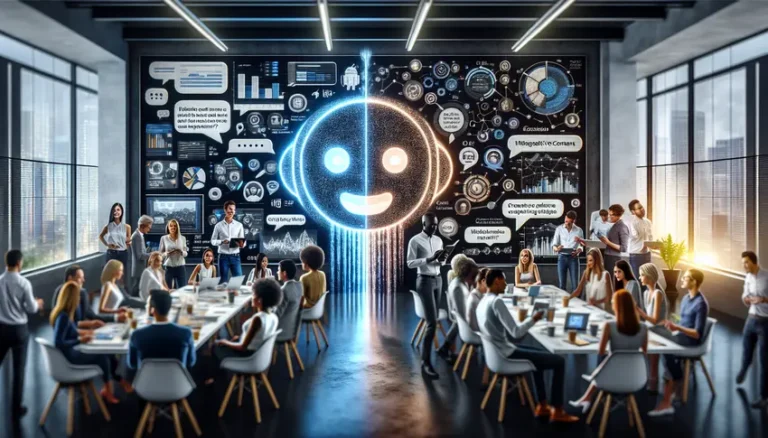Claude 4: A Deep Dive into Anthropic’s Latest Model
The world of AI is constantly evolving, with new models emerging regularly. Anthropic, a leading AI safety and research company, has recently launched its latest model: Claude 4. This guide explores Claude 4’s capabilities, improvements, and potential impact on various industries. We’ll delve into what makes it stand out from its predecessors and competitors, providing a comprehensive overview for anyone interested in the cutting edge of AI.
This article will provide a detailed look into Anthropic’s Claude 4, covering its key features, performance benchmarks, and potential applications. We will also examine its strengths and weaknesses, and how it compares to other leading AI models in the market. Whether you’re a developer, researcher, or simply an AI enthusiast, this guide will provide valuable insights into the capabilities of Claude 4.
What is Claude 4? Understanding Anthropic’s New AI Model
Claude 4 is the latest large language model (LLM) from Anthropic, designed to be helpful, harmless, and honest. It builds upon the foundations laid by previous Claude models, incorporating advancements in architecture, training data, and safety mechanisms. Claude 4 aims to provide more accurate, reliable, and contextually relevant responses, making it a powerful tool for various applications.
Large language models (LLMs) are AI models trained on vast amounts of text data. They can generate human-like text, translate languages, answer questions, and perform other tasks. Claude 4 is designed to excel at these tasks while prioritizing safety and ethical considerations.
Key Features and Capabilities of Claude 4
Claude 4 boasts several key features that set it apart from previous models and competitors. These include enhanced reasoning abilities, improved context understanding, and advanced safety protocols. Let’s explore these features in detail:
- Enhanced Reasoning Abilities: Claude 4 demonstrates a significant improvement in reasoning and problem-solving capabilities. It can handle complex tasks that require logical deduction and critical thinking.
- Improved Context Understanding: The model can better understand and retain information from long conversations or complex prompts. This allows for more natural and coherent interactions.
- Advanced Safety Protocols: Anthropic has implemented robust safety mechanisms to mitigate potential risks associated with AI models. These protocols aim to prevent harmful outputs and ensure responsible use of the technology.
- Tool Use: Claude 4 can operate a computer like a human, given the right tools. This is particularly useful for tasks like web researching and creating spreadsheets.
These features make Claude 4 a versatile tool for various applications, ranging from content creation and customer service to research and development.
Deeper Dive into Claude 4’s Reasoning Abilities
One of the most notable improvements in Claude 4 is its enhanced reasoning ability. This means it can tackle more complex problems and provide more insightful solutions. Think of it like this: previous models might be able to answer simple questions, but Claude 4 can understand the underlying logic and provide a more nuanced response.
For example, if you ask Claude 4 to analyze a complex business report, it can identify key trends, draw conclusions, and provide actionable recommendations. This level of reasoning is crucial for tasks that require critical thinking and problem-solving.
Understanding Claude 4’s Contextual Awareness
Claude 4 excels at understanding and retaining context, even in long and complex conversations. This is a significant improvement over previous models, which often struggled to maintain coherence over extended interactions. Imagine having a conversation with someone who remembers everything you’ve said – that’s the level of contextual awareness Claude 4 offers.
This capability is particularly valuable for applications like customer service, where the AI needs to understand the entire history of a customer’s interaction to provide relevant and helpful support.
The Importance of Safety in Claude 4
Anthropic places a strong emphasis on safety, and Claude 4 incorporates several advanced safety protocols to mitigate potential risks. These protocols are designed to prevent the model from generating harmful, biased, or misleading content. It’s like having a built-in ethical compass that guides the AI’s behavior.
For example, Claude 4 is designed to avoid generating content that promotes violence, discrimination, or misinformation. This commitment to safety is crucial for building trust and ensuring responsible use of AI technology.
Claude 4 vs. Competitors: How Does It Stack Up?
The AI landscape is highly competitive, with models like GPT-4 and Gemini Pro 1.5 vying for dominance. So, how does Claude 4 compare to these competitors? While a direct comparison can be challenging due to the evolving nature of AI, here’s a general overview:
- GPT-4: Known for its impressive text generation capabilities and adaptability, GPT-4 is a strong competitor. However, some concerns exist regarding its potential for generating biased content.
- Gemini Pro 1.5: While details about Gemini Pro 1.5 are limited, it shows strong performance in text-to-code generation and reasoning tasks. A comprehensive comparison is difficult due to the lack of publicly available information.
- Claude 4: Excels in reasoning, context understanding, and safety. It’s particularly well-suited for tasks that require nuanced understanding and ethical considerations.
Ultimately, the best model depends on the specific use case and priorities. Claude 4’s strengths in safety and reasoning make it a compelling choice for applications where these factors are paramount.
Claude 4: A Programmer’s Perspective
From a programmer’s point of view, Claude 4 stands out for its coding prowess. It consistently produces nearly bug-free code on the first try, often outperforming GPT-4 in this area. This can significantly speed up development cycles and improve the quality of code.
This makes Claude 4 a valuable tool for developers looking to streamline their workflow and explore alternative solutions.
Claude 4 for Text Summarization
Claude 4 also shines in text summarization tasks. When tested on summarizing complex documents, Claude 4 delivers more accurate summaries in a smart, human-like style. In contrast, other models may produce summaries that contain errors and feel robotic.
This capability is particularly useful for professionals who need to quickly digest large amounts of information.
Use Cases and Applications of Claude 4
Claude 4‘s versatility makes it suitable for a wide range of use cases and applications across various industries. Here are some notable examples:
- Content Creation: Generating high-quality articles, blog posts, and marketing materials.
- Customer Service: Providing intelligent and personalized support to customers.
- Research and Development: Assisting researchers in analyzing data, generating hypotheses, and writing reports.
- Legal Summarization: Quickly summarizing legal documents and identifying key information.
- Ticket Routing: Efficiently routing customer inquiries to the appropriate support teams.
- Coding Assistance: Helping programmers generate code, debug errors, and explore alternative solutions.
These are just a few examples, and the potential applications of Claude 4 are constantly expanding as developers and researchers explore its capabilities further.
Content Creation with Claude 4
Claude 4 can be a powerful tool for content creators, helping them generate high-quality articles, blog posts, and marketing materials. Its ability to understand context and reason logically allows it to produce engaging and informative content that resonates with audiences.
For example, you can use Claude 4 to brainstorm ideas, create outlines, and even write entire drafts. This can save time and effort, allowing content creators to focus on refining and polishing their work.
Improving Customer Service with Claude 4
Claude 4 can significantly enhance customer service by providing intelligent and personalized support to customers. Its ability to understand context and retain information from previous interactions allows it to provide more relevant and helpful responses.
For example, Claude 4 can be used to answer customer inquiries, troubleshoot problems, and even provide proactive support. This can improve customer satisfaction and reduce the workload on human agents.
Research and Development with Claude 4
Claude 4 can assist researchers in analyzing data, generating hypotheses, and writing reports. Its ability to process large amounts of information and identify key trends can accelerate the research process and lead to new discoveries.
For example, Claude 4 can be used to analyze scientific papers, identify patterns in data sets, and even generate research proposals. This can free up researchers to focus on more creative and strategic tasks.
Claude 4’s System Prompt: A Glimpse Behind the Curtain
Anthropic publishes most of the system prompts for their chat models, offering valuable insights into how these tools are designed to function. The system prompt acts as a sort of unofficial manual, revealing how best to use Claude 4. It also hints at the things the model *used to do* before it was told not to.
The system prompt includes instructions on various aspects of Claude’s behavior, including:
- Introducing Claude and its purpose
- Establishing the model’s personality
- Ensuring model safety
- Defining style guidelines
- Highlighting potential red flags
By examining the system prompt, users can gain a deeper understanding of how Claude 4 operates and how to interact with it effectively.
Establishing Claude 4’s Personality
The system prompt plays a crucial role in establishing Claude 4‘s personality. It includes instructions on how the model should respond in different situations, such as when a user is unhappy or rude. Claude is designed to respond normally and then suggest that the user provide feedback to Anthropic.
The system prompt also addresses how Claude should handle questions about its own preferences or experiences. It instructs Claude to respond as if it were asked a hypothetical question, without mentioning that it is responding hypothetically.
Ensuring Safety in Claude 4’s Responses
Safety is a top priority for Anthropic, and the system prompt includes several guidelines to ensure that Claude 4 responds in a safe and responsible manner. For example, Claude is instructed to be cautious about content involving minors and to avoid providing information that could be used to create weapons.
The system prompt also includes instructions on how Claude should handle ambiguous messages. It instructs Claude to assume that the user is asking for something legal and legitimate if their message could have a legal and legitimate interpretation.
The Future of Claude 4 and AI Development
Claude 4 represents a significant step forward in AI development, but it’s just one milestone in a rapidly evolving field. The future of AI holds even more exciting possibilities, including:
- Continued improvements in reasoning and problem-solving: AI models will become even better at tackling complex tasks and providing insightful solutions.
- Enhanced contextual awareness: AI models will be able to understand and retain context over longer and more complex interactions.
- Greater safety and ethical considerations: AI developers will continue to prioritize safety and ethical considerations, ensuring that AI is used responsibly.
- More widespread adoption across industries: AI will become increasingly integrated into various industries, transforming the way we work and live.
As AI technology continues to advance, it’s important to stay informed and explore the potential benefits and challenges it presents.
The Importance of Ethical AI Development
As AI becomes more powerful, it’s crucial to prioritize ethical considerations. This includes ensuring that AI models are fair, unbiased, and transparent. It also means developing safeguards to prevent misuse and protect user privacy.
Anthropic’s commitment to safety and responsible development is a positive step in this direction, and it’s important for other AI developers to follow suit.
Preparing for the Future of AI
The future of AI is full of potential, but it also presents challenges. To prepare for this future, it’s important to:
- Stay informed about the latest developments in AI: Keep up with the latest research, news, and trends in the field.
- Develop AI skills: Learn how to use AI tools and technologies to enhance your work and personal life.
- Engage in discussions about the ethical implications of AI: Participate in conversations about the responsible use of AI and advocate for policies that promote fairness and transparency.
By taking these steps, we can ensure that AI is used to create a better future for all.
Conclusion
Claude 4 is a powerful and versatile AI model that offers significant improvements over its predecessors and competitors. Its enhanced reasoning abilities, improved context understanding, and advanced safety protocols make it a valuable tool for various applications. As AI technology continues to evolve, Claude 4 serves as a reminder of the potential benefits and the importance of responsible development. By staying informed and engaging in ethical discussions, we can harness the power of AI to create a better future.
FAQs About Claude 4
What are the key differences between Claude 4 and previous Claude models?
Claude 4 boasts enhanced reasoning abilities, improved context understanding, and advanced safety protocols compared to previous models. It can handle more complex tasks, retain information from longer conversations, and avoid generating harmful content.
How does Claude 4 compare to GPT-4?
While both models are powerful, Claude 4 excels in reasoning, context understanding, and safety, while GPT-4 is known for its impressive text generation capabilities. The best model depends on the specific use case and priorities.
What are some potential applications of Claude 4?
Claude 4 can be used for content creation, customer service, research and development, legal summarization, ticket routing, and coding assistance, among other applications.
How does Anthropic ensure the safety of Claude 4?
Anthropic has implemented robust safety mechanisms to mitigate potential risks associated with AI models. These protocols aim to prevent harmful outputs and ensure responsible use of the technology.
Where can I learn more about Claude 4?
You can find more information about Claude 4 on Anthropic’s website and in their official documentation. You can also explore articles, blog posts, and forum discussions about the model.






